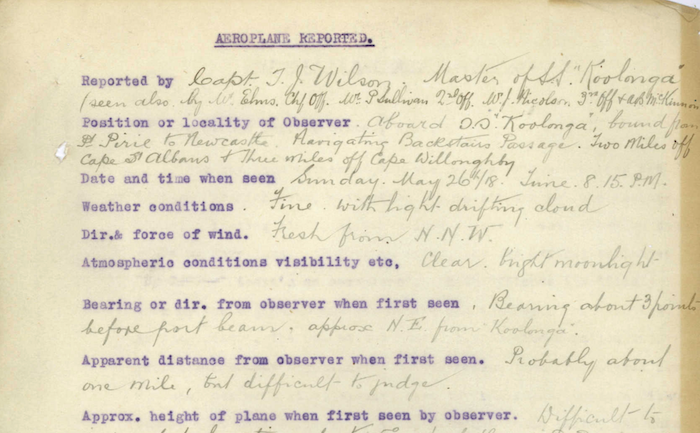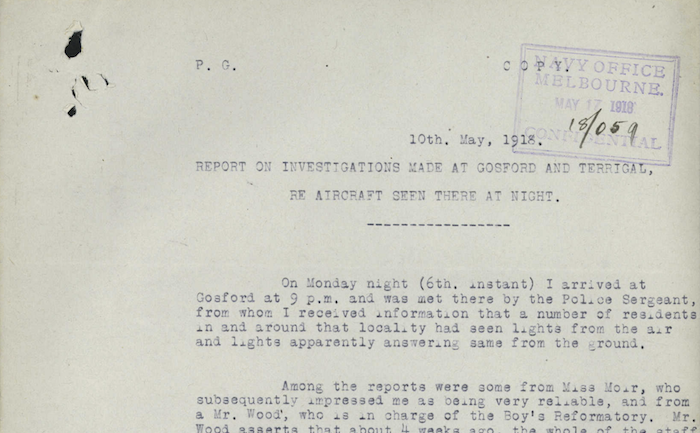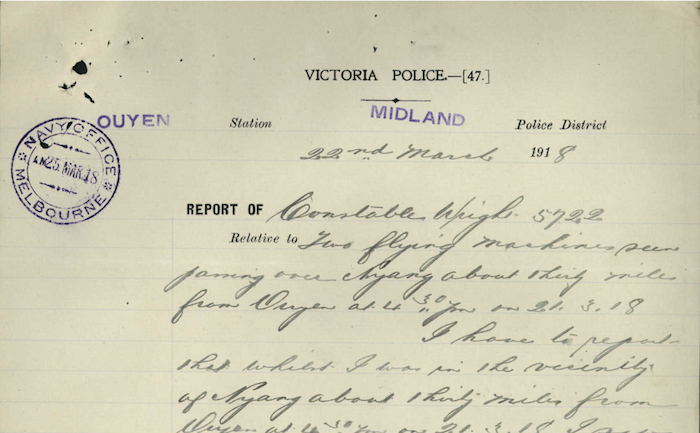
NAA: MP1049/1, 1918/066, page 529 is a statement by Captain T. J. Wilson, master of the SS Koolonga, a merchant vessel plying the Newcastle–Port Pirie route. At 8.15pm on 26 May 1918, Koolonga was off Cape Willoughby, Kangaroo Island, South Australia; Wilson was on the bridge when, ‘Casually looking aloft, he saw a dark square object, which he took to be an aeroplane’.
This is my single favourite mystery aeroplane sighting of the whole 1918 panic, mainly because of all the sailors swearing like sailors, which Wilson freely relayed in his statement, and Captain Fearnley, Senior Naval Officer Newcastle, just as freely censored in his report:
- Nicolson, 3rd Officer: ‘By C[hrist]! there’s an aeroplane’
- AB McKinnon: ‘There’s a b[lood]y Aeroplane!’
- Elms, Chief Officer: ‘God spare my days, that’s a b[lood]y Aeroplane!’
- Sullivan, 2nd Officer: ‘That’s an Aeroplane’ (okay, that one’s less colourful, but he was called up from his cabin to the bridge in his pyjamas, so perhaps he wasn’t quite awake yet)
I was so amused by Elms’s exclamation in particular that not only did I quote it in my article as an example of an aeroplane sighting, I used it as a section heading too. But more seriously, especially when taken together like this, like the conversation of the four boys at Ouyen these excited utterances speak to the immediate responses of witnesses: they were startled, amazed, stupefied by what they were seeing, but also very sure about what they were seeing. According to Wilson, he’d just seen what ‘he took to be an aeroplane’ when Nicolson said ‘there’s an aeroplane’; he avoided asking Elms and Sullivan leading questions when pointing out the object to them, but they both independently identified it as an aeroplane. Still, we don’t know the context for the sighting; perhaps they’d just been discussing mystery aeroplanes at the captain’s table and guessed what everyone else was thinking. On the face of it, though, it’s an impressive report: five experienced seamen who presumably were familiar with the usual natural phenomena seen at sea, all instantly agreeing that this was not natural.

That may be why, despite the very late date of this sighting, the Navy nonetheless took it seriously. The Navy Office sent Fearnley a telegram ordering him to interview Wilson when Koolonga docked at Newcastle (at NAA: MP1049/1, 1918/066, page 531) and another forwarding a message from Cape Willoughby lighthouse (at NAA: MP1049/1, 1918/066, page 530) confirming that Koolonga had reported an aeroplane there. For his part, Fearnley filled out a questionnaire with Wilson’s reponses (above, at NAA: MP1049/1, 1918/066, page 528) under various headings concerning direction of flight, estimated distance, meteorological conditions, and so on, making this probably the most detailed report of the whole panic. (In fact when I first saw this I thought it might have been a standardised form, but Fearnley’s own report, at NAA: MP1049/1, 1918/066, page 526, shows that it was ad hoc.)
As of this month, the Navy Office had an aviation expert of its own, Wing Commander Hugh Maguire, seconded from the RAF (though he is always identified as RNAS) as ‘air service adviser’ and already the author of a proposal for an Australian naval air service. Maguire was sceptical of the Koolonga sighting: on 5 June (at NAA: MP1049/1, 1918/066, page 525) he argued that ‘If aeroplane was only one mile off the noise of the engine should have been clearly visible’, and that ‘it is much more likely that the object seen was a drifting cloud’. Fearnley was already off and running, however; on 4 June he wrote a 2-page memo (at NAA: MP1049/1, 1918/066, pages 455 and 456) for the benefit of the Naval Secretary arguing against the mystery aeroplane sceptics, not just in this case but generally. For example, anticipating the point made by Maguire, he suggested that ‘silencers could be applied to aircraft quite as well as to rifles, Motor cars, motor boats etc’. He pointed to several reports of multiple aircraft seen together (particularly the ones over Sydney) and
5. Assuming the reports as to presence of hostile aircraft to be substantially correct, the following deductions therefrom appear to be inevitable.
(a) that the planes are operating from base aboard one or more enemy vessels off this coast.
(b) that the aerial reconnaissance indicates intended enemy action in one or each of the following directions; (1) mining the coast… (2) attack upon overseas shipping… (3) aerial attack upon coastal shipping docks, depots, works (such as B.H.P.Cos. Steel Works) etc.,6. The number of aircraft apparently available would seem to point to an intended air raid along the coast.
7. The movements of planes reported, indicate that the enemy has Agents ashore both inland and on the coast. Doubtless, communication between the raider and Germany (via America or Java) is established in this way.
To repeat: ‘The number of aircraft apparently available would seem to point to an intended air raid along the coast’! This is the most alarmist interpretation of the mystery aeroplane panic that I have seen, and it is coming from a reasonably senior naval officer. (Which of course is partly why he is concerned: as SNO Newcastle, the defence of the BHP steel works would have been one of his responsibilities — and to be fair, they were the target of an enemy attack, albeit in the next war, not this one.) Nevertheless, I didn’t end up citing this in my article. I think it was because I was more concerned with tracing the panic at the top of the Navy and the Army, which had ended well before now (and Fearnley’s arguments didn’t change this: Maguire wrote another rebuttal, at NAA: MP1049/1, 1918/066, page 454, which the Naval Secretary summarised to Fearnley a bit less scornfully, at NAA: MP1049/1, 1918/066, page 453). I wish I’d had the space to discuss it, but that’s what blogs are for!
![]() This work is licensed under a Creative Commons Attribution-NonCommercial-NoDerivatives 4.0 International License.
Permissions beyond the scope of this license may be available at http://airminded.org/copyright/.
This work is licensed under a Creative Commons Attribution-NonCommercial-NoDerivatives 4.0 International License.
Permissions beyond the scope of this license may be available at http://airminded.org/copyright/.



